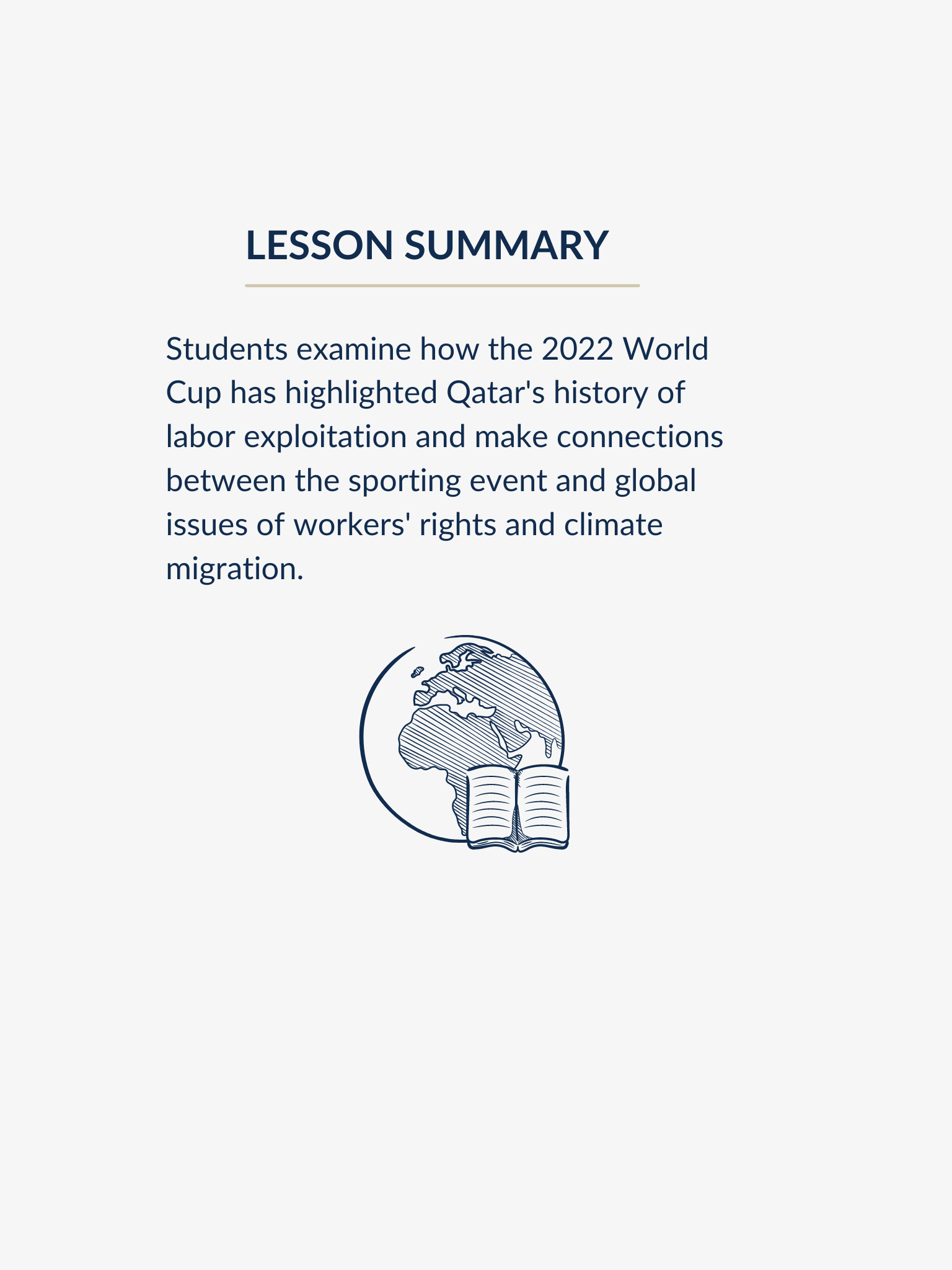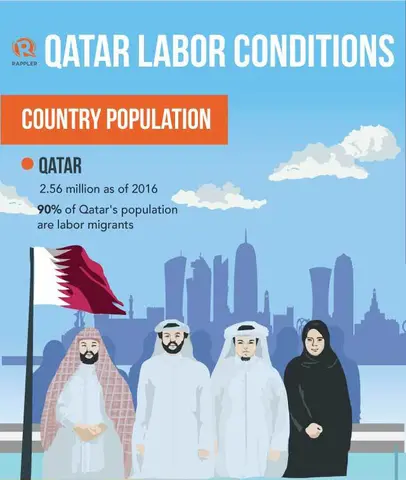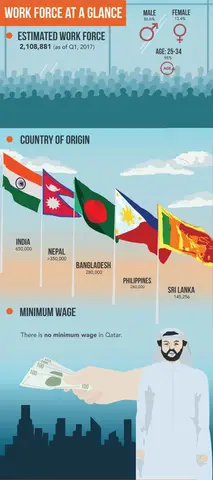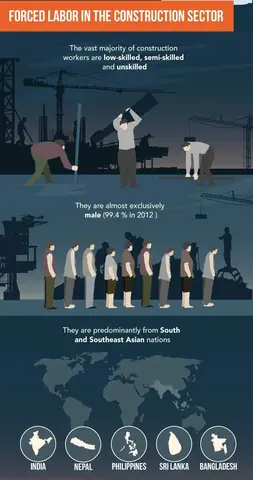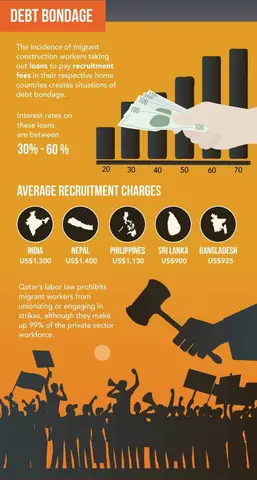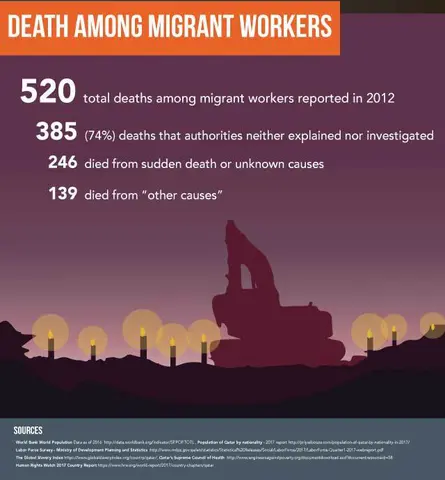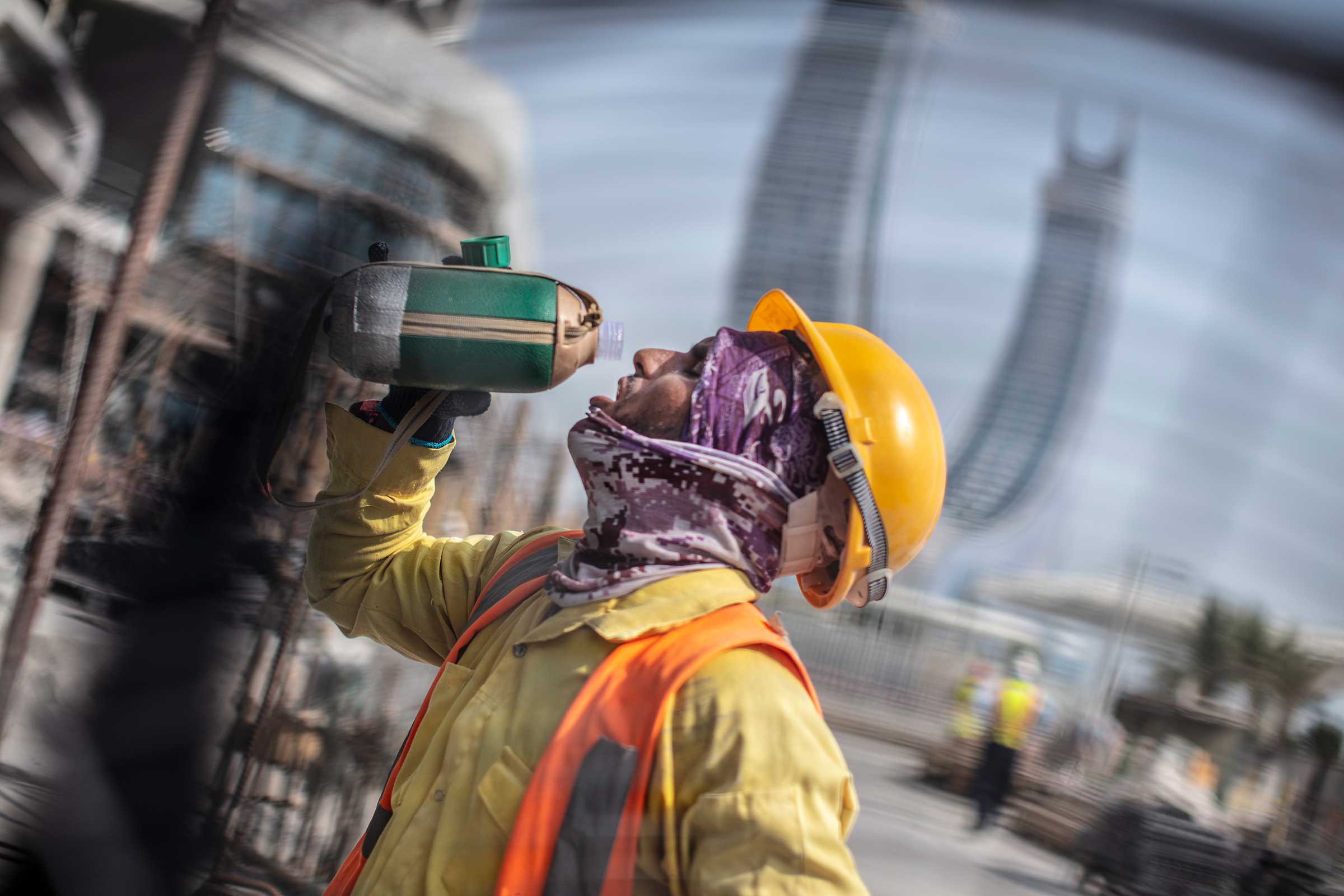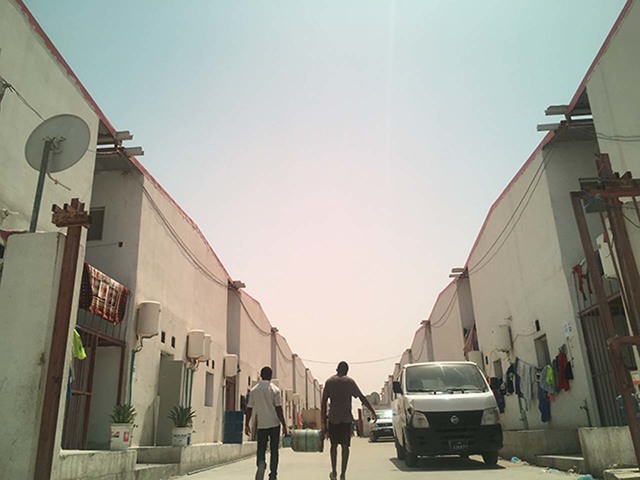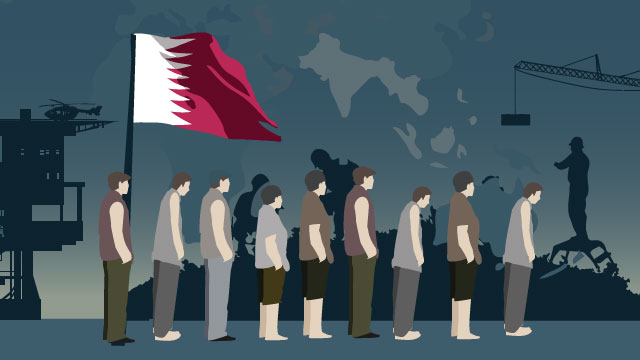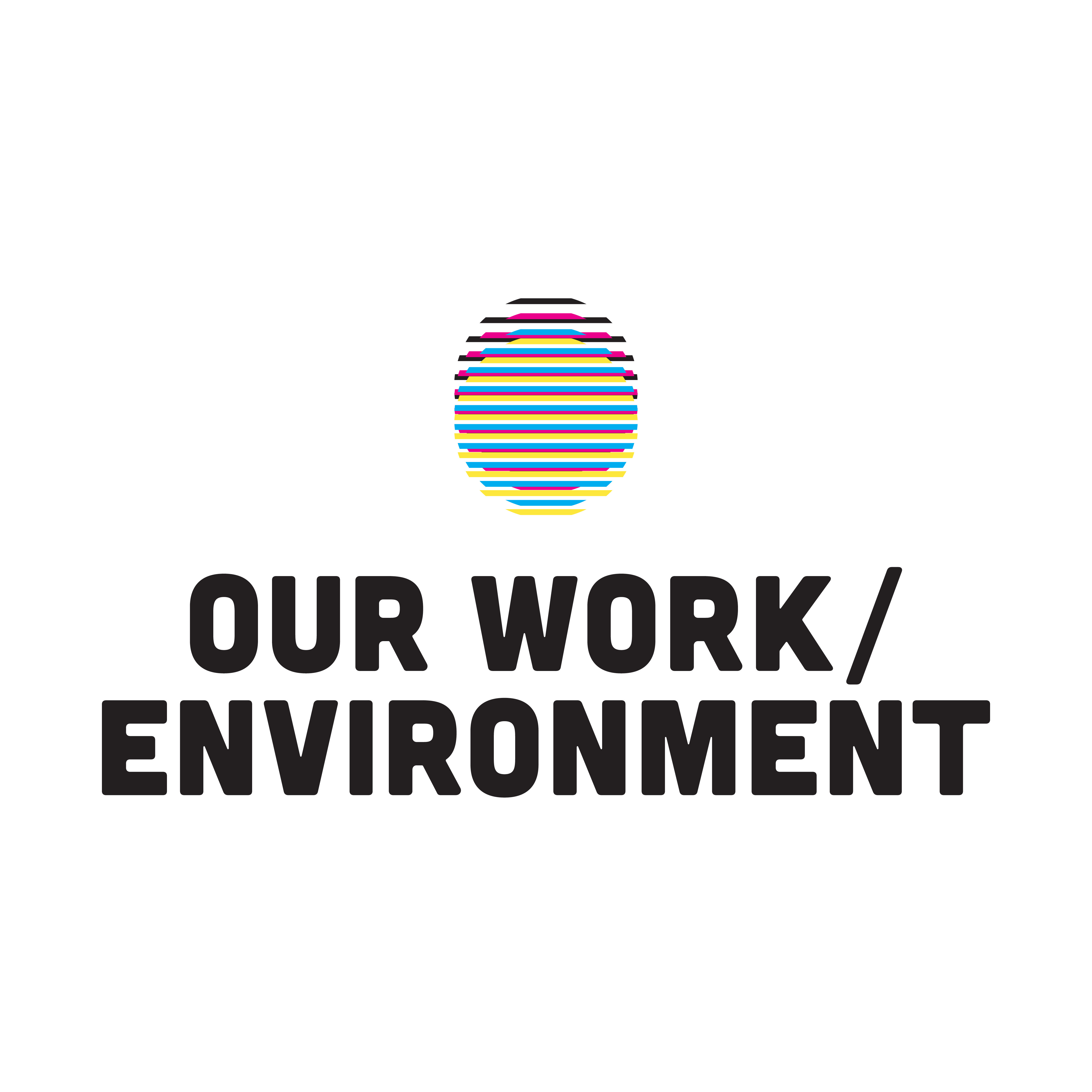Beyond the Headlines is an ongoing series of headline-responsive lesson plans from the Pulitzer Center. These lessons seek to support teachers and students in navigating information, emotion, and perspectives on major news headlines, and to provide critical underreported stories that help connect current events to our personal lives, local communities, and systemic global issues. Browse more lessons in this series here.
Objectives:
Students will be able to...
- Describe how the 2022 FIFA World Cup connects to systemic, global human rights issues.
- Connect with workers' rights and climate migration on a local and/or personal level
- Identify, process, and value their emotions in response to human rights issues surrounding the World Cup
- Take action on workers' rights issues by exercising their writing, research, and/or artmaking skills
Warm-up:
1. Group Discussion: Right now, a major sporting event is happening: the World Cup. What do you know about the World Cup?
- Where is the World Cup this year?
- Who is involved in the World Cup?
- What does a country have to do to prepare to host the World Cup?
2. Review an image of the mosaic outside the World Cup stadium in Qatar from an article by The New York Times.
- What do you think this mosaic represents?
- Why do you think it’s outside of the stadium?
3. In small groups, review the five infographics from "Snapshot: Qatar's Labor Market" by Ana P. Santos for Rappler and the Pulitzer Center. Then discuss the following questions:
- What characterizes the workforce in Qatar? Who are the workers and where are they from?
- Describe their work experiences in Qatar.
- Why do you think people migrate to Qatar for work?
- How do you think it feels to be a migrant in Qatar?
Introducing the Lesson:
Key Vocabulary:
- Migrant worker / Migrant laborer
- Climate migration
- Exploitation
- Kafala system: sponsorship-based employment which legally binds foreign workers to their employers, restricting all workers’ ability to change jobs and still preventing many from leaving the country without their employers’ permission (Source: Amnesty International)
In 2010, Qatar was chosen to be the official host of the 2022 FIFA World Cup, the first time an Arab country was selected. The country has seen rapid growth in infrastructure to host the event and much of that development has progressed due to a largely migrant workforce. Extremely poor working conditions, intense heat, and lack of legislative protection have made migrant workers vulnerable to illness, exploitation, and in some cases, death. On November 29th, CNN reported that the Qatar World Cup Chief Hassan Al-Thawadi admitted that between 400 and 500 migrant workers have died in projects connected to the tournament, but other publications have reported a significantly higher number. According to the New York Times, human rights organizations have put the death toll in the thousands.
In response to increasing coverage of the exploitation of migrants in Qatar, global calls for labor reform have re-centered the factors that drive migration and the systems that take advantage of our world’s most vulnerable populations.
In this lesson, students will learn how the migrant workforce in Qatar has played an instrumental role in preparing the country to host the World Cup. They’ll explore why migrants from Asia and Africa have left their home countries for work in Qatar, the environmental and legislative factors that have made their experience so dangerous, and the long-lasting health outcomes migrants face due to their work. Students will also examine some steps Qatar has taken to promote the safety of migrant workers. By examining the experiences of migrant laborers in Qatar, students will be able to identify the connection between this sporting event and the global issues of workers' rights and climate migration.
Pause to Process:
After introducing the lesson to students, pause to check in with their emotions. Depending on established classroom norms and student comfort levels, students can reflect privately, or share in a small group or whole group format. Consider giving students the option to complete the exercise independently.
- How does learning and talking about this issue make you feel? Try to find at least three descriptive words.
- Can you identify what is making you feel that way? Think about…
- Specific details of the issue
- How the issue does / does not relate to you and people you care about
Educator’s note: Let students know that there are no right or wrong emotional responses to stories and current events. Students may feel sad, angry, or afraid when learning about injustices. They may feel numb because they encounter bad news so often, or because they don’t yet feel a connection to the story. They may feel excited or happy. The point of this exercise is for individuals to identify their feelings, recognize that they have value, and be mindful of them as they begin to dig deeper into this issue.
Going Beyond the Headlines:
Choose one story to explore with your class during the period, or invite students to choose a story based on their own interests. Alternatively, have students jigsaw the texts and then present to each other a summary of the text(s) they explored.
| A History of Labor Abuse in Qatar | Labor Abuse, Extreme Heat, and the World Cup |
| "Promise of a Good Job Abroad Often Ends in Disappointing Reality for Nepalese Workers" [text, photo] Nepalese migrant workers in Qatar routinely face dangerous working conditions, unethical business practices, and unsanitary living quarters. Swindled by both Qatari employers and Nepalese agencies, many workers are trapped in forced or bonded labor. Migrant workers and their families describe the many devastating impacts of working in Qatar. (Find more stories from this project here.) “Qatar: Unpaid Wages, Workers Stranded” [text, photo] Filipino Migrant workers in Qatar are often stranded in labor camps without pay for their work. While some migrants give up on collecting their compensation to return home, others wait for labor disputes with companies like MegaTec to be resolved for their back payment, leaving them jobless in work labor camps, relying on food donations and legal counsel. “How the Kafala System Enslaves Workers in Qatar” [text, photo] The foundation of labor abuse in Qatar is the kafala sponsorship system. Due to this system of subcontracting, labor migrants face dangerous consequences including non-payment of wages, deplorable working and living conditions, and detrimental health outcomes. |
“A Qatar-Style World Cup Building Boom May Not Be Possible in a Hotter World” [text] Described as one of the hottest places on the planet, Qatar’s efforts to diversify its economy by becoming a destination for business, sports, and leisure comes at the expense of working in dangerous environmental conditions. Temperatures will continue to climb in the region and around the world, calling for technological advances and labor solutions. “Thousands of Migrant Workers Died in Qatar’s Extreme Heat. The World Cup Forced a Reckoning” [video, text, photo] Climate change drives migrants from countries like Nepal to Qatar for work where organized labor unions are illegal. Lacking the ability to advocate for better working conditions, they are vulnerable to exploitation in a brutally warm climate. “How Qatar's New Cool-Tech Gear Helps Workers in Extreme Heat” [text, photo] Placed under the spotlight, and with pressure from the international football association FIFA, Qatar’s Ministry of Labor ramped up heat protections by banning all outdoor construction work during the hottest parts of the day during the summer. The Supreme Committee for Delivery and Legacy, the Qatari body in charge of planning and operations for the World Cup, took it a step further, seeking out technological innovations that would allow workers to stay cool, or at least cooler, as they rushed to finish the stadiums during the hottest time of the year. |
Discussion Questions:
After exploring the news story, students discuss:
Understanding the story:
- What is one piece of information in the news story you explored that you already knew?
- What is one piece of information in the news story that surprised or interested you?
- Did you have any questions while exploring the story? What more do you want to know?
Connecting with the story:
- How does the exploitation of labor migrants connect to your community? For example:
- Does your community experience labor exploitation or a related issue?
- Do your community’s actions contribute to the exploitation of workers and/or migrants?
- Does your community have resources that could help alleviate labor exploitation?
- In this story, how do violations of workers' rights intersect with other global issues, such as climate change, migration, and health?
- How can you connect with the story you read on a personal level? For example:
- Do you share experiences with any of the people in this story, or do people close to you share those experiences?
- Have you experienced feelings similar to those the people in this story describe?
Evaluating the story:
- How do you think exploring this story can help understand how the World Cup has highlighted the exploitation of migrant laborers?
- How did the story you read highlight an underreported story? For example:
- Were the voices of people who are often not included in news coverage centered?
- Did the story explore the root causes of an event or its long-term impacts?
- Did you learn about an issue or a place you didn’t know much about before?
Acting on the story:
- What stories do you think might be going underreported in the current coverage of the World Cup and the underlying issue of worker exploitation? What can we do to seek out those stories?
- How are people working to resist and find solutions to the exploitation of migrant laborers? (If you don’t know, do some research!)
- What do you think you and your classmates can do to be part of the solution in strengthening workers' rights and improving work conditions? (After brainstorming, check out the extension activities below for additional ideas.)
Extension Activities:
Option 1. Explore with the Experiences of Migrant Workers Around the World
Step 1. Learn more about the experiences of migrant workers from around the world by reading one of the following articles published with support from the Pulitzer Center:
- "2,300 Miles to Work" by George Butler, Joseph Schottenfeld, and Tim Brown (From Tajikstan to Russia)
- "For an Agricultural Worker, Supporting His Family Means Being Separated From Them" by Sana Malik and Ingrid Holmquist (From Mexico to the U.S.)
- "In Thailand, Myanmar Migrants’ Illicit Unions Fight To Be Heard" by Kiana Duncan (From Myanmar to Thailand)
- "Are Your Tinned Tomatoes Picked by Slave Labor?" by Ayo Awokoya and Tobias Jones (From Gambia, Ghana, Nigeria, Sudan, and Somalia to Italy)
Step 2. Write a short reflection comparing a contrasting the experiences of migrant workers in the article you read to those of migrant workers you read about in Qatar. What do you think accounts for the similarities and differences? Use evidence from both news stories to support your claims.
Option 2. Research How the World Cup Connects to Global Issues
The World Cup is an international sporting event that draws the attention of global communities. In this lesson, we explored how the World Cup both drove the exploitation of migrant workers and highlighted that injustice, generating international criticism that has spurred labor reform in the country. In many ways, the World Cup is a stage: a platform for a range of communities to discuss issues that are underreported in their communities. Research other global issues that are being discussed on the World Cup stage. Craft a presentation summarizing one or more of these issues, and share it with your class.
Option 3. Create an Infographic
Infographics are a great way to raise awareness and share information. Create an infographic that highlights the impacts of labor exploitation in your community. Use the five infographics in explored in this lesson's warm-up as inspiration. Your infographic should include the following:
- A title that summarizes the topic of your infographic
- Data visualizations
- Citations (where does your data come from?)
- Additional images
Students can use Canva's free infographic maker for their project.
Option 4. Reflective Writing
Photographs of the many migrant workers who built the Lusail Stadium in Qatar were featured in a mosaic outside the stadium as a way to spotlight their contribution and sacrifices for the World Cup. The mural disappeared once the games started. (For more information, explore "The World Cup’s Forgotten Team" and/or "A Stadium Mural Celebrated Migrant Workers. When the World Cup Began, It Was Gone.")
Write a one-page essay in response to the following questions:
- Do you think the mural was an effective way to “pay homage to the army of men who had toiled for years under the scorching desert sun to build the cathedrals to the country’s World Cup ambitions?”
- How can Qatar remember the many migrant workers that build the stadiums and surrounding infrastructure?
- Is remembering enough?
Option 5. Artivism
Art can be used as an instrument to inspire social and political change. Activism is a term that describes the intersection of activism and art. With this in mind, create a piece of art that calls attention to labor exploitation, climate migration, or an issue affecting your community. You can draw, paint, write a poem, choreograph a dance, or use photography to inspire change. Be creative and have fun. Consider sharing your work on social media or displaying it at school to inspire local action.
